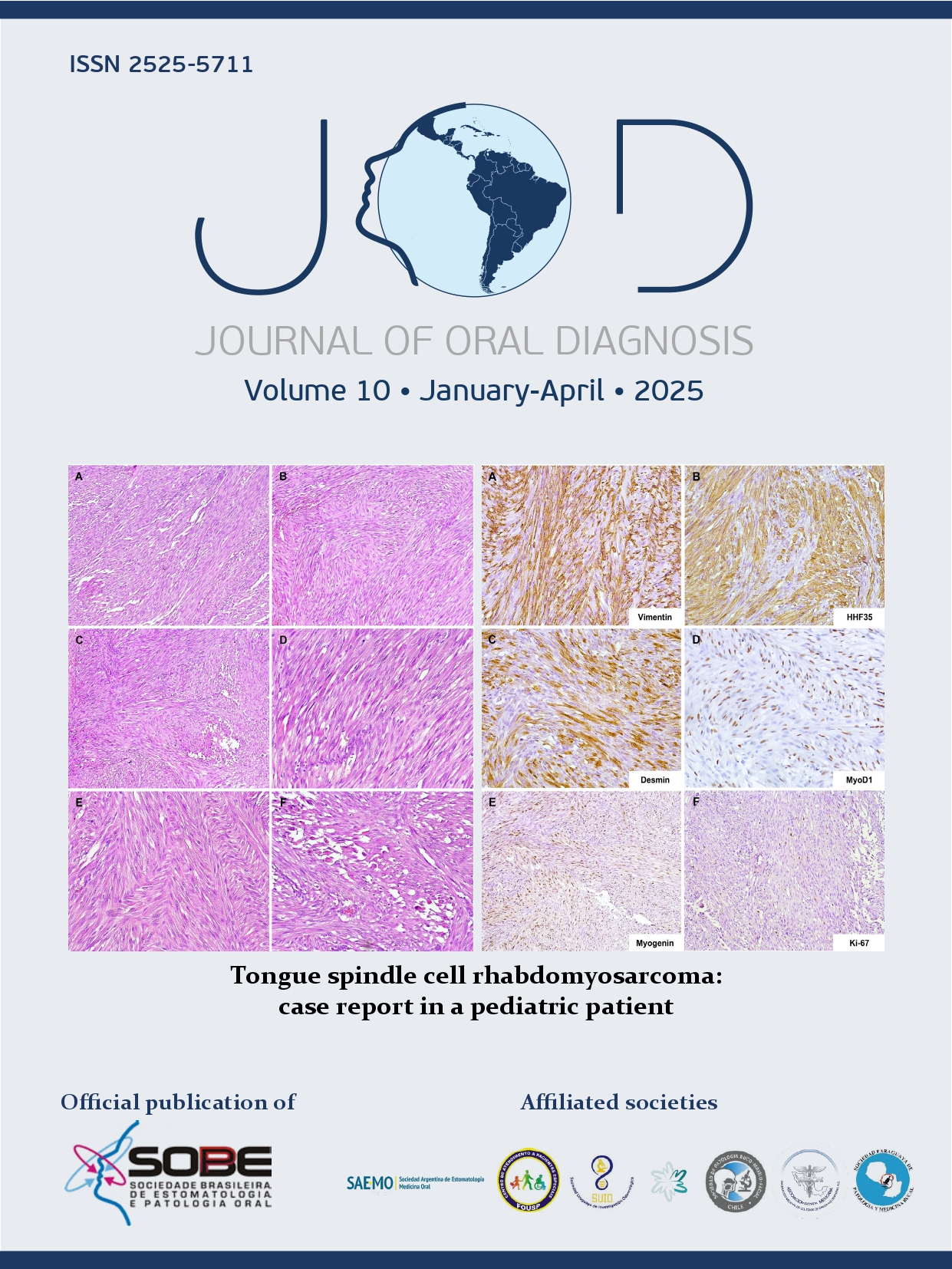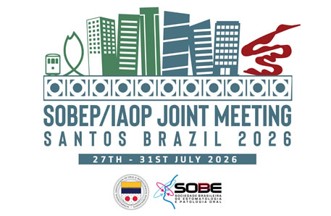The WNT/β-catenin signaling in the context of odontogenic cysts and tumors: an update
DOI:
https://doi.org/10.5327/2525-5711.335Palabras clave:
WNT signaling pathway, Odontogenic cysts, Odontogenic tumors, Immunohistochemistry, Molecular biologyResumen
The Wnt/β-catenin signaling pathway is tightly controlled under typical physiological conditions, being involved in teeth developmental processes. Its dysregulation and the abnormal activation of downstream target genes can result from mutations in essential pathway components. These dysregulations might ultimately foster odontogenic cysts and tumors onset and progression. In this review, we retrieve the main alterations reported in the Wnt/β-catenin signaling pathway in the context of odontogenic cysts and tumors. Increasing evidence supports the involvement of the Wnt/β-catenin pathway disruption in the biology of calcifying odontogenic cyst, odontoma, adenoid ameloblastoma, and ghost cell-containing odontogenic tumors. A deeper understanding of these molecular mechanisms may contribute to improved diagnostic and therapeutic strategies in the future.
Citas
Song P, Gao Z, Bao Y, Chen L, Huang Y, Liu H, et al. Wnt/β-catenin signaling pathway in carcinogenesis and cancer therapy. J Hematol Oncol. 2024;17(1):46. https://doi.org/10.1186/s13045-024-01563-4
Raju R, Piña JO, Roth DM, Chattaraj P, Kidwai FK, Faucz FR, et al. Profiles of Wnt pathway gene expression during tooth morphogenesis. Front Physiol. 2024;14:1316635. https://doi.org/10.3389/fphys.2023.1316635
Liu F, Chu EY, Watt B, Zhang Y, Gallant NM, Andl T, et al. Wnt/beta-catenin signaling directs multiple stages of tooth morphogenesis. Dev Biol. 2008;313(1):210-24. https://doi.org/10.1016/j.ydbio.2007.10.016
Chatterjee S, Devi A, Kamboj M, Narwal A. Localization of beta catenin across the domain of odontogenic lesions: a systematic review. J Oral Pathol Med. 2023;52(10):904-10. https://doi.org/10.1111/jop.13487
Ahn SG, Kim SA, Kim SG, Lee SH, Kim J, Yoon JH. Beta-catenin gene alterations in a variety of so-called calcifying odontogenic cysts. APMIS. 2008;116(3):206-11. https://doi.org/10.1111/j.1600-0463.2008.00893.x
Bastos VC, Coura BP, Guimarães LM, Fernandes BG, Chan ACL, Vargas PA, et al. Adenoid ameloblastoma harbors beta-catenin mutations. Mod Pathol. 2022;35(11):1562-9. https://doi.org/10.1038/s41379-022-01125-4
Fujii S, Nagata K, Matsumoto S, Kohashi K-I, Kikuchi A, Oda Y, et al. Wnt/β-catenin signaling, which is activated in odontomas, reduces Sema3A expression to regulate odontogenic epithelial cell proliferation and tooth germ development. Sci Rep. 2019;9(1):4257. https://doi.org/10.1038/s41598-019-39686-1
Gondak RO, Mariano FV, Sousa SF, Siqueira EC, Díaz KP, Martins LAL, et al. CTNNB1 and APC mutations in odontogenic carcinoma with dentinoid. Oral Surg Oral Med Oral Pathol Oral Radiol. 2020;129(5):e249-e256. https://doi.org/10.1016/j.oooo.2019.08.017
World Health Organization. WHO Classification of Tumours Editorial Board. Head and neck tumours. Lyon: International Agency for Research on Cancer; 2023.
Sekine S, Sato S, Takata T, Fukuda Y, Ishida T, Kishino M, et al. Beta-catenin mutations are frequent in calcifying odontogenic cysts, but rare in ameloblastomas. Am J Pathol. 2003;163(5):1707-12. https://doi.org/10.1016/s0002-9440(10)63528-6
Hassanein AM, Glanz SM, Kessler HP, Eskin TA, Liu C. beta-Catenin is expressed aberrantly in tumors expressing shadow cells. Pilomatricoma, craniopharyngioma, and calcifying odontogenic cyst. Am J Clin Pathol. 2003;120(5):732-6. https://doi.org/10.1309/EALE-G7LD-6W71-67PX
Sousa SF, Moreira RG, Gomez RS, Gomes CC. Interrogation of cancer hotspot mutations in 50 tumour suppressor genes and oncogenes in calcifying cystic odontogenic tumour. Oral Oncol. 2016;57:e1-e3. https://doi.org/10.1016/j.oraloncology.2016.04.010
Yukimori A, Oikawa Y, Morita KI, Nguyen CTK, Harada H, Yamaguchi S, et al. Genetic basis of calcifying cystic odontogenic tumors. PLoS One. 2017;12(6):e0180224. https://doi.org/10.1371/journal.pone.0180224
Dutra SN, Pires FR, Armada L, Azevedo RS. Immunoexpression of Wnt/β-catenin signaling pathway proteins in ameloblastoma and calcifying cystic odontogenic tumor. J Clin Exp Dent. 2017;9(1):e136-e140. https://doi.org/10.4317/jced.53100
Bilodeau EA, Acquafondata M, Barnes EL, Seethala RR. A comparative analysis of LEF-1 in odontogenic and salivary tumors. Hum Pathol. 2015;46(2):255-9. https://doi.org/10.1016/j.humpath.2014.10.018
Kim SA, Ahn SG, Kim SG, Park JC, Lee SH, Kim J, et al. Investigation of the beta-catenin gene in a case of dentinogenic ghost cell tumor. Oral Surg Oral Med Oral Pathol Oral Radiol Endod. 2007;103(1):97-101. https://doi.org/10.1016/j.tripleo.2005.10.037
Oh KY, Hong SD, Yoon HJ. Adenoid ameloblastoma shares clinical, histologic, and molecular features with dentinogenic ghost cell tumor: the histologic spectrum of Wnt pathway-altered benign odontogenic tumors. Mod Pathol. 2023;36(3):100051. https://doi.org/10.1016/j.modpat.2022.100051
Xue J, Zhang W, Zhang J, Bai J, Zhang A, Guo X, et al. Adenoid ameloblastoma shares clinicopathologic, Immunohistochemical, and molecular features with dentinogenic ghost cell tumor: a comparative analysis. Am J Surg Pathol. 2023;47(11):1274-84. https://doi.org/10.1097/PAS.0000000000002104
Soares CD, Carlos R, Morais TML, Almeida OP. Giant dentinogenic ghost cell tumor: a case report. Oral Surg Oral Med Oral Pathol Oral Radiol. 2018;126(4):e215-9. https://doi.org/10.1016/j.oooo.2018.04.003
Xavier GM, Patist AL, Healy C, Pagrut A, Carreno G, Sharpe PT, et al. Activated WNT signaling in postnatal SOX2-positive dental stem cells can drive odontoma formation. Sci Rep. 2015;5:14479. https://doi.org/10.1038/srep14479
França GM, Carlan LM, Pires HF, Oliveira CN, Santos PPA, Galvão HC. Higher immunoexpression of CK14 from the Wnt-1/β-catenin pathway in the development of odontomas. Braz Dent J. 2023;34(6):110-20. https://doi.org/10.1590/0103-6440202305452
Büki G, Antal G, Bene J. Rare germline variants in the adenomatous polyposis coli gene associated with dental and osseous anomalies. Int J Mol Sci. 2024;25(15):8189. https://doi.org/10.3390/ijms25158189
Tanaka A, Okamoto M, Yoshizawa D, Ito S, Alva PG, Ide F, et al. Presence of ghost cells and the Wnt signaling pathway in odontomas. J Oral Pathol Med. 2007;36(7):400-4. https://doi.org/10.1111/j.1600-0714.2007.00550.x
França GM, Pires HF, Silva WR, Morais EF, Freitas RA, Souza LB, et al. Immunohistochemical expression of beta-catenin, BMP4 and TGF-beta in odontomas. Anat Histol Embryol. 2024;53(2):e13024. https://doi.org/10.1111/ahe.13024
Rappaport MJ, Showell DL, Edenfield WJ. Metastatic ghost cell odontogenic carcinoma: description of a case and search for actionable targets. Rare Tumors. 2015;7(3):5813. https://doi.org/10.4081/rt.2015.5813
Bose P, Pleasance ED, Jones M, Shen Y, Ch’ng C, Reisle C, et al. Integrative genomic analysis of ghost cell odontogenic carcinoma. Oral Oncol. 2015;51(9):e71-5. https://doi.org/10.1016/j.oraloncology.2015.06.013
Seki-Soda M, Sano T, Matsumura N, Takayama Y, Gomi A, Ogawa M, et al. Ghost cell odontogenic carcinoma arising in dentinogenic ghost cell tumor with next-generation sequencing cancer panel analysis: a case report. Oral Surg Oral Med Oral Pathol Oral Radiol. 2022;134(3):e58-65. https://doi.org/10.1016/j.oooo.2022.01.005
Ohata Y, Kayamori K, Yukimori A, Sumikura K, Ohsako T, Harada H, et al. A lesion categorized between ghost cell odontogenic carcinoma and dentinogenic ghost cell tumor with CTNNB1 mutation. Pathol Int. 2018;68(5):307-12. https://doi.org/10.1111/pin.12659
Sakamoto S, Ando T, Mizuta K, Ono S, Konishi M, Miyauchi M, et al. Ghost cell odontogenic carcinoma arising in dentinogenic ghost cell tumor, peripheral: a case report. Pathol Int. 2023;73(8):367-72. https://doi.org/10.1111/pin.13351
Mariano FV, Gondak RO, Scarini JF, Silva ECA, Caravina G, Scapulatempo-Neto C, et al. Odontogenic carcinoma with dentinoid in long-term follow-up with 2 recurrences. Int J Surg Pathol. 2020;28(2):181-7. https://doi.org/10.1177/1066896919871662
Descargas
Publicado
Cómo citar
Número
Sección
Licencia
Derechos de autor 2025 Lucas Fabian Polti , Fernanda Aragão Felix , Mariana Silveira Souza , Rafael Aguiar de Sousa , Gabriela Ribeiro de Araujo , Silvia Ferreira de Sousa

Esta obra está bajo una licencia internacional Creative Commons Atribución 4.0.













